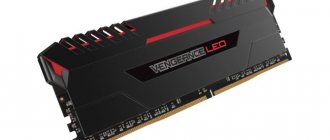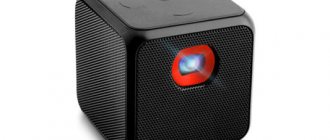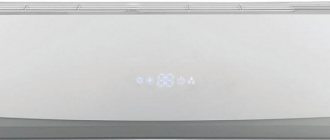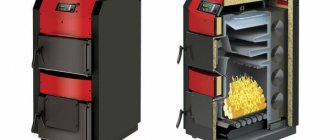Building or upgrading a computer is not a momentary matter. RAM is one of the most important parts for both an office and gaming PC or laptop.
When choosing RAM, you need to pay no less attention to it than to the motherboard or drives, because the response speed, operation and stability of the entire system will largely depend on it.
In addition, the potential of hardware is not fully revealed if the RAM is chosen incorrectly.
But many modern systems work with the DDR4 format. What is this format, and what boards are the best?
Let's figure it out.
Rating of the TOP 15 best DDR4 RAM modules
| Place | Name | Price |
| TOP 3 best DDR4 RAM modules: price/quality | ||
| 1 | HyperX Fury HX426C16FB3K2/16 8 GB | Find out the price |
| 2 | Samsung M378A1K43CB2-CTD 8 GB | Find out the price |
| 3 | HyperX Fury HX432C16FB3K2/16 8 GB | Find out the price |
| TOP 3 best 8GB DDR4 RAM modules | ||
| 1 | Crucial CT8G4DFS824A | Find out the price |
| 2 | Silicon Power SP008GBLFU240B02 | Find out the price |
| 3 | Crucial CT8G4DFS8266 | Find out the price |
| TOP 3 best 16GB DDR4 RAM modules | ||
| 1 | Crucial CT16G4SFD8266 | Find out the price |
| 2 | HyperX Fury HX432C16FB3K2/32 | Find out the price |
| 3 | HyperX Impact HX426S15IB2/16 | Find out the price |
| TOP 3 best 32GB DDR4 RAM modules | ||
| 1 | HyperX Fury HX432C16FB3/32 | Find out the price |
| 2 | Crucial CT32G4RFD4266 | Find out the price |
| 3 | Samsung M393A4K40CB2-CTD | Find out the price |
| TOP 3 best DDR4 RAM modules for Ryzen | ||
| 1 | HyperX Fury RGB HX432C16FB3AK2/16 | Find out the price |
| 2 | Samsung M471A1K43CB1-CTD | Find out the price |
| 3 | Kingston ValueRAM KVR26S19S8/8 | Find out the price |
How to choose and what to pay attention to?
When choosing DDR4 RAM, you should pay attention to the following characteristics:
- Compatibility . Not all models are compatible with this or that part of the hardware, so you need to check this parameter or consult a specialist.
- Cooling efficiency . The parameter depends on the presence of a radiator both on the bar itself and on the built-in radiators. In addition, heatsinks affect the appearance of RAM, and this is often an important indicator for gamers or streamers. Almost all modern models have built-in radiators, but some older models do not have them.
- Volume . More often than not, this is the first thing consumers look at. The volume should not be small or large, since not all editions of operating systems can support large RAM parameters. If technically possible, it is better to use two 8 GB sticks than one 16 GB, or two 16 GB than one 32 GB.
- Frequencies and timings affect the operating speed of installed modules . The lower the latency, the faster the processor accesses memory cells and the higher the speed of the PC. Frequency indicators affect the speed of information processing and, therefore, also increase the speed of the entire system as a whole.
It should be remembered that modern processors can only support the new RAM format and ignore the old one, that is, if you buy a DDR3 format stick, it simply will not work in the system.
You should also remember that the formats are not compatible with each other and do not work simultaneously - you should give preference to one or the other, even if the system and hardware supports both DDR4 and DDR3.
Testing methodology and test stand
Who is the main “consumer” of high-speed memory? Those who use powerful PCs for gaming or working with “heavy” applications, and, of course, overclockers. Therefore, the test methodology is also focused on studying, first of all, the overclocking capabilities of the memory.
The AIDA64 utility package is used, the TechArp benchmark, which measures video encoding speed, as well as two games: DiRT Rally and GTA V in FullHD display mode with graphics settings from medium to ultra. The choice of these particular games is due to the fact that they are sensitive to the speed of the memory installed in the system.
The verification is carried out in two stages:
- The first stage - a set of a pair of modules is used in dual-channel mode with settings activated from the XMP profile. If you do not enable XMP, the memory will default to 2133 MHz.
- The second stage is the search for the maximum overclocking that the RAM modules participating in the test are capable of. We are looking for a balance between high frequencies and timings. At the same time, heavy tests on video encoding and running games were not carried out. Actually, in this case, this is overclocking for the sake of overclocking, a purely sporting interest, showing what can be achieved and whether the modules will work at all. Only AIDA64 and SuperPi 8M are used.
As a test stand, or rather, two stands (we are testing on both platforms), we used:
| CPU | AMD Ryzen 7 1800X | Intel Core i7 8700K |
| Motherboard | ASUS Crosshair VI Hero | ASUS ROG Maximus X Apex |
| Video card | NVidia GeForce GTX 1080 Ti | |
| Storage device | SSD Samsung 960 Pro 512GB | |
| power unit | Seasonic Prime Titanium 650W | |
| OS | Windows 10 | |
The best DDR4 RAM modules: price/quality
HyperX Fury HX426C16FB3K2/16 8 GB
Model with weak overclocking characteristics and average frequency and throughput with XMP support.
The two-module kit is suitable for motherboards with a limitation of 2666 MHz.
Peer-to-peer model, suitable for increasing RAM on standard work PCs.
The low overclocking potential is due to old Nanya A-Die memory chips based on the 20 nm process technology.
The maximum operating temperatures are 90 degrees, but on average the dies, even under high loads, do not heat up above 45-50 degrees - cooling works at altitude.
Specifications:
- Form factor: DIMM 288-pin;
- Frequency: 2666 MHz;
- Bandwidth: 21300 MB/s;
- ECC/XMP support: no/yes;
- CAS Latency (CL): 16;
- Number of modules: 2.
pros
- good technical characteristics;
- average price;
- set of two modules.
Minuses
- unaccelerated.
Samsung M378A1K43CB2-CTD 8 GB
Well-known brand model, supplied with one strip . The memory has a high overclocking
potential and at the same time very budget-friendly.
If you have a high-quality motherboard, the module can easily take the frequency 1000 MHz higher.
Widespread on the market, and if desired, the computer can be equipped with several brackets.
In addition, the sticks are compatible with almost all RAM sticks from other manufacturers.
Specifications:
- Form factor: DIMM 288-pin;
- Frequency: 2666 MHz;
- Bandwidth: 21300 MB/s;
- ECC/XMP support: no/no;
- CAS Latency (CL): 19;
- Number of modules: 1.
pros
- possibility of gradual modernization;
- market prevalence;
- low price;
- overclocking potential.
Minuses
- simple design.
HyperX Fury HX432C16FB3K2/16 8 GB
Not a bad RAM, widely known to everyone who is interested in hardware . Model
It is classified as non-overclockable, but this is compensated by good throughput and frequency performance.
A “set it and forget it” board for those who don’t bother with delays, timings and other terms.
It fully corresponds to the stated characteristics, which makes it relevant for the average user.
During overclocking, according to user reviews, it is somewhat unstable, but at the same time it provides stable operation at the clock frequency declared by the manufacturer.
Specifications:
- Form factor: DIMM 288-pin;
- Frequency: 3200 MHz;
- Bandwidth: 25600 MB/s;
- ECC/XMP support: no/yes;
- CAS Latency (CL): 16;
- Number of modules: 2.
pros
- design;
- adequate price;
- presence of radiators.
Minuses
- no overclocking potential.
Quad Channel DDR4 Memory Kits
Continuation
We have already reviewed five sets of DDR4 memory, which is compatible with motherboards based on the Intel X99 chipset and, accordingly, processors codenamed Haswell-E (LGA2011-v3 socket). However, the range of DDR4 memory is constantly increasing, so in this article, which can be considered a continuation of the first review, we will look at several more four-channel DDR4 memory kits with a total capacity of 16 GB.
Let’s immediately make a reservation that we are talking about non-register (UDIMM) non-ECC memory. This clause may seem strange, but some boards with the Intel X99 chipset support server processors of the Intel Xeon E5 v3 family, which support ECC memory, both registered (RDIMM) and non-registered (UDIMM). Therefore, we emphasize once again that we will not consider server memory in this article - and in the future, by DDR4 memory we will mean unregistered (UDIMM) non-ECC memory.
We have already made general comments regarding DDR4 memory (about the need for radiators, etc.), so we will not repeat ourselves, but will immediately begin with a more detailed acquaintance with the participants in our testing.
Corsair Vengeance LPX DDR4 DRAM 2800 MHz (CMK16GX3M4A2800C16)
Judging by the information on the Corsair website, the range of DDR4 memory is simply huge. All Corsair DDR4 memory is divided into two series: Vengeance LPX and Dominator Platinum. The main (if not the only) difference between these series is that they use memory module heatsinks of different designs (in the Vengeance LPX series the heatsinks are a little simpler).
Further, in each series there are kits that differ in the number of modules, total memory capacity, frequency and timings. Well, in the Vengeance LPX series, differences between different memory sets may also lie in the color of the radiator. In a word, there are kits for every taste.
The Vengeance LPX series includes sets of two, four and eight memory modules, and the volume of the module itself can be 4, 8 or 16 GB. In addition, memory modules may differ in frequency and heatsink color. In particular, there are memory kits with frequencies of 2133, 2400, 2666, 2800, 3000, 3200 and 3300 MHz. Well, radiators can be black, red and blue.
In the future, we will look at the Corsair Vengeance LPX DDR4 DRAM 2800 MHz memory kit (CMK16GX3M4A2800C16).
This is a set of four memory modules with a total capacity of 16 GB. The memory modules have a stated operating frequency of 2800 MHz and timings of 16-18-18-36 with a supply voltage of 1.2 V.
Memory modules are equipped with black cooling radiators, which are two metal plates glued to each side of the module. At the same time, the memory modules themselves are single-sided, that is, the memory chips are located only on one side of the module.
On our test bench with the default settings in the UEFI BIOS, the Corsair Vengeance LPX DDR4 DRAM 2800 MHz (CMK16GX3M4A2800C16) started up at a frequency of 2133 MHz with timings of 15-15-15-36.
Well, the promised frequency of 2800 MHz with timings 16-18-18-36 and a supply voltage of 1.2 V is implemented only through the XMP profile. Moreover, this memory corresponds to two XMP profiles: one for a frequency of 2800 MHz, and the second for a frequency of 3000 MHz.
However, when the XMP profile was activated at 2800 MHz, the system, alas, did not boot.
Of course, this does not mean that the Corsair Vengeance LPX DDR4 DRAM 2800 MHz memory (CMK16GX3M4A2800C16) cannot operate at the declared frequency and that we were deceived. After all, in addition to the memory modules themselves, this frequency must also be supported by the memory controller, which is built into the processor, and the motherboard itself. As for the processor, we used an Intel Core i7-5960X. Moreover, we had two copies of the processor at our disposal. We tried both instances, but the result was the same: when the XMP profile is activated, the system does not boot. It was possible, of course, to try another motherboard, however, we did not do this, and not only because it was not available, but also because we decided to use the same board as in the first part of our testing.
So, this result speaks volumes about the fact that even if the box says 2800 MHz, it doesn’t mean anything. There is also a lot written on the barn, and, as you know, there is firewood there.
Coarsening of the timings, as well as manipulation of the module supply voltage, also did not allow us to run this memory at a frequency of 2800 MHz. Moreover, the Corsair Vengeance LPX DDR4 DRAM 2800 MHz memory did not start even at a frequency of 2666 MHz. And the highest frequency at which we were able to get this memory kit to work was 2400 MHz. Moreover, at this frequency the memory started up with timings 12-12-12-34, however, stable operation (without freezing) was achieved only with timings 12-13-13-36.
Below are the test results in the AIDA64 program for a set of Corsair Vengeance LPX DDR4 DRAM 2800 MHz memory modules (CMK16GX3M4A2800C16) with default settings (DDR4-2133; 15-15-15-36) and overclocked (DDR4-2400; 12-13- 13-36).
Kingmax DDR4 Nano Gaming RAM 3200 MHz
Kingmax produces DDR4 Nano Gaming RAM series. This series includes memory kits with frequencies of 2666, 2800, 3000, 3200 and 3400 MHz, and the memory kits themselves can consist of either two or four modules. The module capacity can be 4 or 8 GB.
The memory of this series supports Intel XMP 2.0. A distinctive feature of the Nano Gaming RAM series memory modules is the absence of decorative heatsinks. However, according to the manufacturer, instead of radiators, in this case the proprietary Nano Thermal Dissipation cooling technology is used. The meaning of this technology is that a thin layer of diamond-like carbon and silicon particles is applied to the surface of memory chips, which increases the efficiency of heat removal.
Next, we will look at a set of four Kingmax DDR4 Nano Gaming RAM 3200 MHz memory modules.
As the name suggests, this memory should support a frequency of 3200 MHz. Naturally, we are talking about an XMP profile. In general, all Kingmax DDR4 Nano Gaming RAM in the original is DDR4-2133. And all the declared high frequencies of this memory are, of course, overclocking through the activation of XMP profiles. And, as we already had the opportunity to see using the example of Corsair memory, it is not a fact that if the box says 3200 MHz, you can actually make this memory work at that frequency.
By default, this memory runs at 2133 MHz with timings of 15-15-15-36 (as it should be).
If you look at the information about XMP profiles, then, indeed, this memory corresponds to a profile at a frequency of 3200 MHz with timings of 16-18-18-36 and a supply voltage of 1.35 V.
Moreover, once, we even managed to boot the system with the DDR4-3200 XMP profile activated and even take AIDA test readings.
However, at this memory frequency the system was very unstable and periodically did not boot.
We were able to achieve stable operation of the system only at a memory frequency of 2667 MHz with timings of 15-15-15-36.
Below are the test results in the AIDA64 program for a set of Kingmax DDR4 Nano Gaming RAM 3200 MHz memory modules with default settings (DDR4-2133; 15-15-15-36) and overclocked (DDR4-2667; 15-15-15-36 ).
G.Skill Ripjaws F4-2800C16Q-16GRK
The range of DDR4 memory from G.Skill is simply huge, and just listing all the possible sets of this memory is a rather tedious task. In short, the company offers sets of two, four and eight memory modules, and the capacity of one module is 4 or 8 GB. In addition, modules are available with frequencies of 2133, 2400, 2666, 2800, 3000, 3200 and 3400 MHz. Add to this decorative radiators of different colors - and we get that the number of possible combinations is simply huge.
All DDR4 memory from G.Skill is presented in the Ripjaws 4 series. We tested a set of four of their G.Skill Ripjaws F4-2800C16Q-16GRK memory modules.
The declared frequency of the memory modules is 2800 MHz with timings 16-16-16-36 and a supply voltage of 1.2 V. G.Skill Ripjaws F4-2800C16Q-16GRK memory modules have a black decorative heatsink.
On our test bench with default UEFI BIOS settings, the G.Skill Ripjaws F4-2800C16Q-16GRK memory started up at 2133 MHz with timings of 15-15-15-35 and a supply voltage of 1.2 V.
But when the XMP profile is activated, the memory frequency is set not to 2800 MHz, but to 2200 MHz and the memory operates in DDR4-2200 mode with timings of 16-16-16-36.
And this despite the fact that the DDR4-2800 XMP profile with timings 16-16-16-36 is available in the SPD.
And at the promised frequency of 2800 MHz (if set manually), the G.Skill Ripjaws F4-2800C16Q-16GRK memory did not work on our test bench at any timings.
The highest frequency at which the G.Skill Ripjaws F4-2800C16Q-16GRK memory was able to run turned out to be 2400 MHz. At this frequency, the memory was able to work with timings of 13-13-13-36 with a supply voltage of 1.2 V.
The following are the test results for a set of G.Skill Ripjaws F4-2800C16Q-16GRK memory modules at a frequency of 2133 MHz (15-15-15-35) and 2400 MHz (13-13-13-36) in the AIDA64 program.
Kingston HyperX Predator HX430C15PBK4/16
Memory Kingston HyperX Predator HX430C15PBK4/16 belongs to the overclocker series of Kingston HyperX Predator memory.
As follows from the information on the manufacturer’s website, the company produces a very wide range of DDR4 memory kits. The capacity of the kits can be 16, 32 and 64 GB, the number of modules in one kit can be four or eight, and the capacity of one module can be 4 or 8 GB. At the same time, the company produces DDR4 memory kits with effective frequencies of 2133, 2400, 2666, 2800 and 3000 MHz.
On the Kingston website there is information on deciphering the name of the memory module. Using this information, you can understand that the name of the HX430C15PBK4/16 module encrypts the following information: this is a UDIMM DDR4-3000 memory module with CAS 15 latency. The memory belongs to the HyperX Predator series, is equipped with a black heatsink, and the total capacity of the set of four modules is 16 GB.
A more detailed specification of the Kingston HyperX Predator HX430C15PBK4/16 memory modules states that this is DDR4-2133 memory with timings of 15-15-15 and a supply voltage of 1.2 V. The memory supports two XMP profiles: DDR4-2666 with timings of 14-14 -14-36 and a supply voltage of 1.5 V, as well as DDR4-3000 with timings 15-16-16-39 and a supply voltage of 1.5 V.
On our test bench with default UEFI BIOS settings, the Kingston HyperX Predator HX430C15PBK4/16 memory started up at 2133 MHz with timings of 15-15-15-36 and a supply voltage of 1.2 V.
The most interesting thing is that when the first XMP profile is activated in the UEFI BIOS, the memory actually operates at a frequency of 2667 MHz with timings of 14-14-14-36. But the second profile, which, in theory, should run the memory at a frequency of 3000 MHz, runs it at a frequency of 2400 MHz with timings of 15-16-16-39.
But at the promised frequency of 3000 MHz, alas, the memory does not start, even if the timings are coarse. Moreover, we were unable to run this memory at 2800 MHz. The maximum frequency at which the memory started was 2667 MHz. True, the timings were reduced to 12-13-13-36.
The following are the test results of a set of Kingston HyperX Predator HX430C15PBK4/16 memory modules at a frequency of 2133 MHz (15-15-15-36) and 2667 MHz (12-13-13-36) in the AIDA64 program.
Transcend TS512MLH64V1H
For desktop systems, Transcend does not produce many DDR4 memory modules. To be more precise, there are only two of them. These are the TS512MLH64V1H module with a capacity of 4 GB and the module TS1GLH64V1H with a capacity of 8 GB. Both modules are DDR4-2133, and the supply voltage is 1.2 V. As you can see, there is no show off here. There are no different memory kits, no decorative heatsinks, and overclocking XMP profiles are not provided.
Next, we will look at a set of four Transcend TS512MLH64V1H modules (total capacity of the set is 16 GB).
On our test bench with default UEFI BIOS settings, the Transcend TS512MLH64V1H memory started up in full accordance with the specification, that is, at a frequency of 2133 MHz with timings of 15-15-15-36 and a supply voltage of 1.2 V.
Moreover, it turned out that this memory can operate at a frequency of 2400 MHz with timings of 13-13-12-36.
The following are the results of testing a set of Transcend TS512MLH64V1H memory modules at a frequency of 2133 MHz (15-15-15-36) and 2400 MHz (13-13-12-36) in the AIDA64 program.
Testing
So, in total, five sets of four-channel DDR4 memory took part in our testing, each of which was tested in two operating modes: with default settings and with settings corresponding to maximum memory overclocking. The default settings for all memory sets are the same: frequency 2133 MHz and timings 15-15-15-36.
| Memory | Frequency | Timings |
| Corsair Vengeance LPX DDR4 DRAM 2800 MHz (CMK16GX3M4A2800C16) | 2400 | 12-13-13-36 |
| Kingmax DDR4 Nano Gaming RAM 3200 MHz | 2667 | 15-15-15-36 |
| G.Skill Ripjaws F4-2800C16Q-16GRK | 2400 | 13-13-13-36 |
| Kingston HyperX Predator HX430C15PBK4/16 | 2667 | 12-13-13-36 |
| Transcend TS512MLH64V1H | 2400 | 13-13-12-36 |
Since in all our tests all memory kits in DDR4-2133 mode with timings of 15-15-15-36 produced almost identical results, in the future we will simply talk about DDR4-2133 memory with timings of 15-15-15-36, meaning any kit with default settings.
For testing we used a stand with the following configuration:
- processor - Intel Core i7-5960X;
- motherboard - Gigabyte X99-Gaming G1 WiFi;
- chipset - Intel X99;
- drive - Intel SSD 520 Series (240 GB):
- Operating system: Windows 8.1 (64-bit).
We did not change the testing methodology, just like the stand itself. Let us only recall that we carried out testing using real applications from our test script iXBT Application Benchmark 2015. At the same time, from the test package iXBT Application Benchmark 2015 we deliberately excluded tests whose execution speed depends on the data storage subsystem (copy speed, installation and uninstallation speed applications, etc.), as well as several other tests that do not make sense in terms of memory testing.
As a result, the following tests were used:
- MediaCoder x64 0.8.33.5680,
- Adobe Premiere Pro CC 2014.1,
- Adobe After Effects CC 2014.1.1,
- Photodex ProShow Producer 6.0.3410,
- Adobe Photoshop CC 2014.2.1,
- ACDSee Pro 8
- Adobe Illustrator CC 2014.1.1,
- Adobe Audition CC 2014.2,
- WinRAR 5.11 archiving,
- WinRAR 5.11 unzipping.
And before considering the results of our testing, let's dwell on such an aspect as the influence of the number of memory channels on computer performance. In order to find out how the number of memory channels affects operating speed, we tested DDR4-2133 memory with timings of 15-15-15-36 once in four-channel mode, and a second time in dual-channel mode. For this we used the same memory kit, but once we used all four modules, and the second time we used only two modules. Of course, the amount of memory also changed (in four-channel mode - 16 GB, and in dual-channel mode - only 8 GB), but this is not critical, since 8 GB of memory is quite enough for all the tests we used.
The test result for dual-channel memory operating mode is presented in the diagram. The speed of task execution in a four-channel memory mode is taken as 100%.
As can be seen from the test results, doubling the memory bandwidth when moving from dual-channel to quad-channel operating mode changes little. The maximum that can be expected is a 2-3% increase in performance, and even then not in all applications. That is, the vast majority of modern applications simply do not need the bandwidth of DDR4-2133 memory in four-channel operating mode and the bandwidth of dual-channel mode is quite sufficient. Naturally, we are talking about using an Intel Core i7-5960X processor with its 20 MB L3 cache. But most likely, for the other two processors of the Haswell-E family (Core i7-5930K, Core i7-5820K) with a 15 MB L3 cache, we will get a similar result.
Now let's look at the results of testing memory kits in four-channel mode. The results are presented in diagrams, and for each set the dimensionless speed of completing the task, expressed as a percentage, is given. The speed of task execution in DDR4-2133 mode with timings of 15-15-15-36 is taken as 100%.
Actually, there is no point in discussing each of the tests separately, especially since we cannot add anything new in comparison with what was already said in the first part of our testing. Therefore, let’s look at the results and analyze them all at once.
As can be seen from the testing results, by increasing the memory frequency from 2133 MHz to 2667 MHz, and even with lower timings, it is possible to achieve, at best, an increase in performance (task execution speed) by 8%. And not in all applications - in most applications, the effect of using faster memory is much more modest and amounts to no more than 5%, and some applications do not show any increase at all when installing high-speed memory.
conclusions
Actually, the conclusions that can be drawn based on the results of the new testing are quite predictable and were already formulated by us in the first part of our review. Speedy memory comes from the evil one. All DDR4 memory on the market today is DDR4-2133, and higher frequencies are achieved through overclocking using XMP profiles. Moreover, the fact that the memory says DDR4-3000 or DDR4-3200 does not mean at all that it will operate at that frequency. Moreover, we may say sedition, but in many cases these inscriptions do not mean anything at all. For the overclocking XMP profile to work, it is necessary, firstly, that the memory controller built into the processor also supports high-frequency memory, and secondly, that the motherboard also supports high-frequency memory (and not just in words). We can say that we were simply unlucky with the processor or motherboard. But who guarantees that you will be lucky and buying high-speed memory will make sense?
Best 8GB DDR4 RAM Modules
Crucial CT8G4DFS824A
RAM with a good amount of single stick is one of the best models in the budget segment.
This volume is very widespread, and if you wish, purchasing a second bar will not be difficult.
The overclocking potential of the bar is good, the chips operate stably even at a frequency of 2800 MHz; on new processors it is possible to increase it to 3200 MHz, however, you have to sacrifice latency.
Supplied in a sealed plastic container, which guarantees the newness of the die.
When overclocking, there is a noticeable difference between single-channel and dual-channel modes, so it is better to use two modules at the same time.
Specifications:
- Form factor: DIMM 288-pin;
- Frequency: 2400 MHz;
- Bandwidth: 19200 MB/s;
- ECC/XMP support: no/no;
- CAS Latency (CL): 17;
- Number of modules: 1.
pros
- possibility of gradual modernization;
- availability;
- price;
- overclocking potential.
Minuses
- no cooling radiators.
Silicon Power SP008GBLFU240B02
A simple custom model for office or work PCs . Also suitable for
inexpensive gaming builds.
Overclocking to higher frequencies is possible. Does not overheat, comfortable to use even without overclocking.
Economical energy consumption is also noted . When working with graphics it also does not heat up and works very stably.
A good budget option for non-trivial use.
Specifications:
- Form factor: DIMM 288-pin;
- Frequency: 2400 MHz;
- Bandwidth: 19200 MB/s;
- ECC/XMP support: no/no;
- CAS Latency (CL): 17;
- Number of modules: 1.
pros
- timings;
- frequency range;
- stability;
- price.
Minuses
- high percentage of defects.
Crucial CT8G4DFS8266
Model similar to Crucial CT8G4DFS824A with increased CAS Latency and clock speed . Also
easy to accelerate, widespread and affordable for the average user.
However, there are problems with insertion into the grooves.
Works stably without increasing voltage.
Another disadvantage is the lack of a radiator. Users also report problems with inserting the strip into the grooves.
Specifications:
- Form factor: DIMM 288-pin;
- Frequency: 2666 MHz;
- Bandwidth: 21300 MB/s;
- ECC/XMP support: no/no;
- CAS Latency (CL): 19;
- Number of modules: 1.
pros
- possibility of gradual modernization;
- availability;
- price;
- overclocking potential.
Minuses
- no cooling radiators;
- difficulties with insertion into grooves;
- sometimes not perceived by the system.
Kingston FURY Renegade = HyperX Predator
In principle, there is no doubt that the Kingston FURY Renegade 32GB DDR4-3600 will start up normally on this assembly. On the official ASUS website we were able to find a QVL list or a list of qualified RAM suppliers, which indicates support for HyperX FURY 32GB DDR4 3000 CL15 memory modules in the same layout: two 16 GB modules. However, its ceiling is 3000 MHz (with an XMP profile), while with our Renegade series the manufacturer allows operation at frequencies up to 3600 MHz (but operation at higher frequencies with these brackets is not officially guaranteed).
So, it is obvious that we have before us an improved version of HyperX FURY represented by Kingston FURY (in fact, this is an advanced analogue of HyperX Predator 32GB DDR4-3600). Like the Predator modules, the Kingston FURY Renegade 32GB DDR4 reaches a maximum frequency of 3600 MHz when the Intel XMP 2.0 profile is activated. This is a kind of certified overclocking. Keep in mind that the XMP option must be activated in the motherboard's UEFI (formerly BIOS) settings, otherwise you will not get any automatic overclocking. In the case of ROG MAXIMUS IX CODE, we simply install the memory, select the desired mode and restart the computer.
- Exploitation
How to check processor and video card compatibility
Please note that on the old version of UEFI (version 0221 dated October 19, 2021), the motherboard had problems with the HyperX Predator 32GB DDR4-3000 kit (under the symbol HX430C15PB3K2) during a cold start. In particular, this is evidenced by information from a user thread on the official ASUS forum dedicated to updating the BIOS. So, version UEFI 1301 dated April 20, 2021 significantly increased the stability of DRAM and added support for new modules, including the Predator series from HyperX and, accordingly, the Renegade from Kingston.
Best 16GB DDR4 RAM Modules
Crucial CT16G4SFD8266
A simple bracket for increasing the memory of slow laptops . Model with reduced
power consumption and optimization for new generation processors.
It is distinguished by reliability and increased throughput, but the performance is generally average.
Easy to install, not demanding on the system.
One of the best options for those who are not very versed in hardware and the intricacies of overclocking.
Among other things, it reduces power consumption and increases overall system performance.
Specifications:
- Form factor: SODIMM 260-pin;
- Frequency: 2666 MHz;
- Bandwidth: 21300 MB/s;
- ECC/XMP support: no/no;
- CAS Latency (CL): 19;
- Number of modules: 1.
pros
- optimization for new processors;
- reduced energy consumption;
- easy to install.
Minuses
- overcharge.
HyperX Fury HX432C16FB3K2/32
Not a bad board for those who are not used to squeezing maximum capabilities out of hardware . Chips
The dies belong to the C-die generation, the manufacturer keeps the rest of the data secret.
A great option for the average gaming PC or for graphics or video work.
3200 MHz is quite enough to improve performance and reduce PC response time.
For those who prefer to overclock their PC to the maximum, the kit is clearly not suitable.
The total height of the module is 34 mm, the radiators are removable, so if necessary, installing powerful coolers will not interfere with the dies.
Specifications:
- Form factor: DIMM 288-pin;
- Frequency: 3200 MHz;
- Bandwidth: 25600 MB/s;
- ECC/XMP support: no/yes;
- CAS Latency (CL): 16;
- Number of modules: 2.
pros
- presence of radiators;
- simplicity and lack of unnecessary functionality;
- reasonable price.
Minuses
- no overclocking options.
HyperX Impact HX426S15IB2/16
A good option for upgrading a laptop for those who are not particularly versed in hardware and the intricacies of overclocking.
This is an “install and work” model – it easily compiles with most systems; users note a noticeable increase in operating speed.
The bar is one of the most affordable at the beginning of 2021 in terms of quality and volume ratio, as well as one of the fastest and highest quality, according to user reviews.
Specifications:
- Form factor: SODIMM 260-pin;
- Frequency: 2666 MHz;
- Bandwidth: 21300 MB/s;
- ECC/XMP support: no/yes;
- CAS Latency (CL): 15;
- Number of modules: 1.
pros
- adequate price;
- ease of installation;
- Compatible with many laptop models.
Minuses
- no overclocking options;
- unreliable packaging, there is a risk of damage to contacts.
Overclocking
And for dessert – overclocking. The modules were overclocked to the maximum, which, unfortunately, most often did not allow for full testing. But the fact that the memory was launched at certain frequencies shows the potential and suitability for experiments to increase the operating frequency of the RAM.
G.Skill memory confirmed its reputation as one of the most overclockers. At least 3 sets worked at a frequency of 4400 MHz with timings of 19-21-21-42 when the power supply was increased to 1.7-1.8 V. The least need to increase the supply voltage was for Trident Z DDR4-4000.
The Corsair Vengeance RGB kits also showed excellent overclocking potential, reaching 4300 MHz with timings of 19-21-21-40 and a voltage of 1.75 V.
I was also surprised by the simplest Crucial DDR4-2133 kit, which reached a frequency of 2933 MHz with a supply voltage of 1.45 V. Just don’t forget about the lack of heatsinks on the memory chips.
Best 32GB DDR4 RAM Modules
HyperX Fury HX432C16FB3/32
Similar to model HX432C16FB3AK2/16 . Adapted for Ryzen processors. Downtime in
installation and meeting all the characteristics declared by the manufacturer.
A current model for those who do not overclock, and increasing the memory is simply necessary to improve the speed of the PC and undemanding games.
However, when assembling, you should remember that the module is quite high, and you should make sure that when installing the cooler and radiator they will not block the slot.
Specifications:
- Form factor: DIMM 288-pin;
- Frequency: 3200 MHz;
- Bandwidth: 25600 MB/s;
- ECC/XMP support: no/yes;
- CAS Latency (CL): 16;
- Number of modules: 1.
pros
- design;
- adequate price;
- presence of radiators.
Minuses
- no overclocking potential.
Crucial CT32G4RFD4266
2021 ECC server model . Mainly used on PC with
large amounts of data, less often – as a gaming one.
It has average frequency and throughput, and produces fairly high timing.
At the same time, it lends itself well to overclocking to 3200 MHz.
It is worth remembering that the model is a server model, and since the information of such a die requires additional clock cycles from the processor, using the ECC algorithm, the memory demonstrates a much lower operating speed compared to conventional dies for desktop PCs.
Specifications:
- Form factor: DIMM 288-pin;
- Frequency: 2666 MHz;
- Bandwidth: 21300 MB/s;
- ECC/XMP support: yes/no;
- CAS Latency (CL): 19;
- Number of modules: 1.
pros
- ECC support;
- volume;
- relatively low price.
Minuses
- quite rare.
Samsung M393A4K40CB2-CTD
Server RAM, considered one of the best among boards with similar capacity.
It is demanding on the processor, so when choosing this model you need to look at hardware compatibility.
It is distinguished by a fairly high price and not the most common occurrence.
Due to the volume and high price, it is mainly used in server rooms; for stationary PCs, different strips of smaller volume are preferable.
Specifications:
- Form factor: DIMM 288-pin;
- Frequency: 2666 MHz;
- Bandwidth: 21300 MB/s;
- ECC/XMP support: yes/no;
- CAS Latency (CL): 19;
- Number of modules: 1.
pros
- ECC support;
- volume.
Minuses
- quite rare;
- high price.
Expert opinion
Vlad
HyperX Fury 32GB DDR4 3200MHz DIMM 288-pin CL16 HX432C16FB3/32
Not bad RAM for computers in the above-average price category. There are no special advantages, but there are no disadvantages either. Dimensions will fit any tower cooler. While maintaining standard timings, the RAM easily overcomes the 3600 MHz mark when overclocked. You can reach 3733 MHz.
Basil
HyperX Fury 8GB DDR4 2666MHz DIMM 288-pin CL16 HX426C16FB3/8
Four months of use. The flight was normal, I got what I wanted and expected to see, even a little more - I switched from a very old system (MSI board from the mid-late 2000s + Core2Duo 8400 + 4gb RAM) New combination: Asus Prime h410m-e + Intel i5 10400f + Gammax 300b blue + Geforce 650 gtx 2 gb (old) + CoolerMaster MWE White 450 + Kingston A400 480 gb + 2 pcs. Hyperx Fury 8gb + Ginzzu SL 220 case At medium settings, it can easily run popular multiplayer games, even despite the rather outdated video card, there are 70-110 fps (but I tuned and cleaned Windows for performance). I don’t play new games, so I can’t tell you anything. I’m not entirely satisfied with the purchase, according to subjective feelings after 4 months of work - I would have taken a Samsung or a micron instead of a Kingston. But technically everything is smooth, so it’s a matter of taste.
Egor
Patriot Memory SL 16GB DDR4 2400MHz SODIMM 260-pin CL17 PSD416G240081S
Excellent price-quality ratio. Works like a clock, started up with a module on micron chips, unfortunately the laptop only runs at 2133 in frequency. The flight has been excellent for two months of operation. If you need to buy again, choose the same one without hesitation.
Alexey M.
Samsung 8GB DDR4 2666MHz SODIMM 260-pin CL19 M471A1K43CB1-CTD
There was a similar bracket from the factory. The new one fit perfectly, even if it was from early batches. The increase in work speed is noticeable. Do not forget that it is better to make 2 identical planks than one large one. This will enable dual-streaming and speed up.
Ivan
Patriot Memory SL 16GB DDR4 2400MHz DIMM 288-pin CL17 PSD416G24002
Quietly drives up to 3200 MHz and 3400 MHz. Mother of x570 steel legend and 3600x. Maximum performance according to Aida turned out to be a memory frequency of 3400 MHz, timings 20-20-20-50-70-1, Infinity Fabric frequency 1700 MHz, voltage 1.35. Speed is exactly DDR4. 16 gigs is enough for everything, I reserved a couple of them for a disk in RAM.
Arthur
Patriot Memory SL 8GB DDR4 2666MHz SODIMM 260-pin CL19 PSD48G266681S
Good RAM, system speed has increased significantly - these are advantages. I didn’t notice any shortcomings because there can’t be any. Upgrading the Legion y520 laptop took 10 minutes, and the system speeded up significantly. The flight is normal. I recommend.
Sergey
GoodRAM 8GB DDR4 2666MHz DIMM 288-pin CL19 GR2666D464L19S/8G
Price-overclocking. Native frequency 2666 timings 19-19-19 43 Overclocking to 3200 MHz Memory timings 16-18-18-36 (CL-RCD-RP-RAS) at a voltage of 1.350 V. I didn’t push it any further, I don’t see the point. Percent Intel. Disadvantages: For me this is not a disadvantage, there are no radiators, but they are not needed. I'm not a fan of lights and all sorts of whistles.
Sergey Bulatov
Crucial 4GB DDR4 2400MHz DIMM 288-pin CL17 CT4G4DFS824A
I bought it for my work computer and had to increase it to 8 GB. (4+4) was no longer enough to simultaneously operate a browser with a bunch of open tabs, WhatsApp, Telegram and several Excel tables. Now everything works great. I recommend.
Dima
HyperX Predator RGB 8GB DDR4 3200MHz DIMM 288-pin CL16 HX432C16PB3A/8
Started up on ASRock B450 Steel Legend with Ryzen 1600X when XMP profile was enabled at 3200 MHz, overclocked to 3400 without increasing timings, works stably. Beautiful lighting, synchronized without problems with the ASRock Polychrome RGB motherboard software. I overclocked it to 3400 MHz without increasing the timings, the LinX test passed successfully, I didn’t get more than 3400 without errors. I bought one bar with the expectation of adding a second one later. I recommend purchasing the RAM.
Novel
Crucial 4GB DDR4 2400MHz DIMM 288-pin CL17 CT4G4DFS824A
Started on the Asrock b450 motherboard at 3200 with timings 19-19-19-39, Ryzen 3 2200g, without raising the voltage. Two 4Gb sticks. It is probably possible to get lower values, but with increasing voltage, I did not do this - the computer is not a gaming one. I think there is no point in overpaying for all sorts of beautiful radiators.
Ivan Zolotukhin
Patriot Memory VIPER 4 BLACKOUT 16GB (8GBx2) DDR4 3200MHz DIMM 288-pin CL16 PVB416G320C6K RAM Patriot Memory VIPER 4 BLACKOUT 16GB (8GBx2) DDR4 3200MHz DIMM 288-pin CL16 PVB416G320C6K
Memory is like memory. Got up without any problems. Set 3200 MHz for 16 lines. The required 3200 MHz works. xmp profiles are in place. On Ryazhenka zen+, the maximum provided frequency is 2933, there are no problems with working at 3200. Theoretically, you can overclock it more, but you will have to do it manually, I have not tried. There are radiators, especially if the case is well ventilated, then the memory does not heat up.
Vladimir Skvortsov
Crucial 8GB DDR4 2400MHz SODIMM 260-pin CL17 CT8G4SFS824A
Great memory! It started up without any problems in dual-channel mode with a frequency of 2400 at timings of 17:17:17:39 paired with the stock bracket from Micron 8atf1g64hz-2g3h1 (Dell 7567 laptop). Latency 72.7 ns. The module manufacturer is Crucial, and the DRAM is from Micron. When I turned it on for the first time, the BIOS warned me about memory expansion and suggested rebooting. Well, the best part is that I grabbed this bar for almost nothing, for 1600₽ (2100 promotional price - 500 store bonuses).
Best DDR4 RAM Modules for Ryzen
HyperX Fury RGB HX432C16FB3AK2/16
This bar is one of the best high-frequency models . She stands out not only for her
technical characteristics in the form of clock frequency, low latency timing and high throughput, but also an original backlight design.
The model is equipped with profiles to increase the performance limit. A gaming bar whose lighting is synchronized with the rest of the system components.
Specifications:
- Form factor: DIMM 288-pin;
- Frequency: 3200 MHz;
- Bandwidth: 25600 MB/s;
- ECC/XMP support: no/no;
- CAS Latency (CL): 16;
- Number of modules: 2.
pros
- high throughput;
- backlight synchronization;
- performance profiles.
Minuses
- not compatible with some coolers.
Samsung M471A1K43CB1-CTD
The optimal board for speeding up laptops . Characteristics declared
manufacturer, correspond to reality.
Easily compatible with boards from other brands, easy to install.
It is also easy to compile with many laptop models, which makes the bar almost universal.
Fast and inexpensive model for memory expansion.
Specifications:
- Form factor: SODIMM 260-pin;
- Frequency: 2666 MHz;
- Bandwidth: 21300 MB/s;
- ECC/XMP support: no/no;
- CAS Latency (CL): 19;
- Number of modules: 1.
pros
- quality;
- ease of installation;
- versatility;
- reasonable price.
Minuses
- The packaging is unreliable and there is a risk of damage to the contacts.
Kingston ValueRAM KVR26S19S8/8
One of the best RAM for laptops running on new generation processors.
A good factory thermal run is one of the advantages of the model, since the company carries out a similar technological operation on all trims, including budget ones.
Inserts and works almost without problems.
A universal option for increasing the RAM of modern laptops. Also compatible with Samsung panels.
Specifications:
- Form factor: SODIMM 260-pin;
- Frequency: 2666 MHz;
- Bandwidth: 21300 MB/s;
- ECC/XMP support: no/no;
- CAS Latency (CL): 19;
- Number of modules: 1.
pros
- factory thermal run;
- prevalence and accessibility;
- adequate price;
- universality for systems;
- Compatible with Samsung panels.
Minuses
- no cooling radiators.
TOP 7 best memory modules for games
This review is dedicated to the best memory modules for games. The capacity of each model varies from 8 to 32 GB, and the speed - from 1600 to 3200 MHz. Some modules are faster and have higher capacity, while others are more affordable. Other advantages that these models have to offer include compatibility, cooling, low latency and other features.
Available 8GB (2x4GB) 1600MHz DDR3 CL10 DIMM Kit | HyperX
This DDR3 kit is not the fastest in the world and not the largest in volume. However, for those who have already spent their budget on a high-end processor, motherboard and graphics card, this is a viable solution.
Kingston is not as prestigious a brand as some of the others we'll look at next, and the prices reflect this, but it is a reputable brand that is often recommended for those who want quality without going into debt. But this is not an ideal solution, after all.
Characteristics
- Volume: 8 GB.
- Number of modules: 2x4GB.
- Architecture: DDR3 CL10 DIMM.
- Cooling: Standard radiator.
- Compatibility: AMD and Intel x86/64.
- Speed: 1600 MHz.
Performance:
This RAM isn't the fastest, but it's fast enough to handle random access requirements for game data once it's loaded. However, due to the fact that the number of modules is two and the speed is average, the game loading time may be increased.
The number of modules is also an issue if you have a small board with two or four slots, which limits the amount of memory you can end up using. However, the average gamer on a budget won't have any issues other than the loading times that most are accustomed to from their console experience.
Overall rating: 7
| pros | Minuses |
|
|
Conclusion
While not ideal, gamers who want to spend most of their money on a good processor and graphics card (which is reasonable) will find this a good solution.
Mid-Range Solutions - 8GB (4GB x2) DDR3 1600 MT/s Set | Ballistix
Ballistix was one of the leading manufacturers of gaming optimized RAM and was also popular among graphic designers. It has given that title to some other brands that we'll see later, but that doesn't mean Ballistix RAM isn't reliable.
If you need slightly faster speeds than the Kingston can provide, but also have a budget to consider, then the slightly higher price for this RAM will improve boot times.
Characteristics
- Size: 8 GB.
- Number of modules: 2x4GB.
- Architecture: DDR3 PC3-12800 UDIMM.
- Cooling: High quality aluminum radiator.
- Compatibility: AMD and Intel x86/64 (optimized for Intel).
- Speed: 1600 MHz
Performance
It's still not the fastest RAM in the world. Back in the day it could have easily held that title and I had the same RAM from Ballistix that I used in a media server and it works great for video content.
For games this will work fine, but again, two modules take up slots, which if you are building a budget gaming system may interfere with future upgrades. But the loading time is better than in the previous version
Overall rating: 8
| pros | Minuses |
|
|
Conclusion
If I were building a new budget computer, I would probably choose this RAM, just like I did for my media server. My only concern is that the UDIMM can sometimes go crazy if the memory management in the program is not written correctly.
Budget Set 16GB (8GB x2) DDR4 3000MT/s | Ballistix
Another offering from Ballistix is a higher-end budget RAM with significantly increased speed and more storage capacity. If you're on a budget but don't want to skimp on speed or slot availability, this is a trade-off you can definitely live with.
Characteristics
- Volume: 16 GB.
- Number of modules: 2x8GB.
- Architecture: DDR4 PC5-24000 DIMM.
- Cooling: High quality aluminum radiator.
- Compatibility: AMD and Intel x86/64 (optimized for Intel).
- Speed: 3000 MHz
Performance
When it comes to budget RAM, this is the best deal, offering 16 GB in two modules, good speed and modern architecture. However, if you need DDR3 (which is possible), this RAM may not work. For some motherboards and some RAM, it is possible to reverse support for the DDR4 architecture on a DDR3 board, but this is a coin toss and a risky endeavor.
Overall rating: 8
| pros | Minuses |
|
|
Conclusion
This RAM may require a newer motherboard, but if you want to use the new architecture while staying within budget, this is a good choice. However, I only recommend this for slot optimization.
Low Cost High Performance 32GB (2 x 16GB) 3000MHz C15 DRAM Memory Kit for DDR4 Systems | Corsair
Now we begin the big game. Corsair is one of the leading brands for RAM and motherboards, and Vengeance is their modern high-performance RAM line. It's not cheap, but in the realm of high-end RAM, it's one of the more affordable offerings.
This memory is fast, powerful and has low latency.
Characteristics
- Total volume: 32 GB.
- Number of modules: 2x16GB.
- Architecture: DDR4 C15 UDIMM.
- Cooling: High quality aluminum radiator.
- Compatibility: AMD and Intel x86/64 (optimized for Intel).
- Speed: 3000 MHz.
Performance
These are the most affordable memory modules in their top lineups, with overclocking and auto-profiling features that allow serious gamers to calibrate their system to get the most out of it. It's not the top of the line for the Corsair Vengeance, as we'll soon see, but it's a force to be reckoned with.
Be careful with overclocking as these modules do not have the best cooling.
Overall rating: 8
| pros | Minuses |
|
|
Conclusion
If you're serious about gaming but don't really want to spend on memory alone, you can't go wrong with this RAM. Be careful with overclocking!
High-End | RGB PRO 16 GB (2x8 GB) DDR4 3200 MHz C16 LED | Corsair
It's currently the top of the line Vengeance RAM, with incredible speeds, RGB lighting, and a serious heatsink that makes overclocking much safer.
Characteristics
- Volume: 16 GB.
- Number of memory modules: 2x8GB.
- Architecture: DDR4 C16 DIMM.
- Cooling: high-quality aluminum radiator with RGB lighting system, ventilation holes.
- Compatibility: AMD and Intel x86/64 (optimized for Intel).
- Speed: 3200 MHz.
Performance
Don't let the low price fool you - this is due to the smaller memory sticks. This is the most powerful RAM Corsair currently offers.
Overall rating: 9
| pros | Minuses |
|
|
Conclusion
Corsair fans who want the best gaming experience in 2019 will want to use this RAM. This is what's on my current computer and I'm emulating a Wii U at full speed.
Best for Online Gaming 3000 MHz (PC4 24000), 8 GB, Dual Channel DDR4 | Patriot
Patriot is another leading name in RAM, and the dual-channel control in their Viper series significantly speeds up communication in online games thanks to the parallelism it provides.
Characteristics
- Volume: 8 GB.
- Number of modules: 2x4GB.
- Architecture: DDR4 PC4 2400 DIMM.
- Cooling: High quality aluminum radiator.
- Compatibility: AMD and Intel x86/64 (optimized for Intel).
- Speed: 3000 MHz.
Performance
If you mostly play online games, you need more parallelism and faster communication capabilities that this Viper RAM provides. It's not the best option for current-gen single-player games, but it will work well for them, albeit with some increased load times and the occasional (very rare) frame drop.
Overall rating: 8
| pros | Minuses |
|
|
Conclusion
Simply put, this parallelism makes it best for heavy online gaming, so rejoice MMO, RTS and online FPS players, this is the RAM for you.
Best for Heavy Gaming RGB Series DDR4 16GB (2 x 8GB) (PC4 25600) | G.Skill
This TridentZ RGB RAM from G.Skill is the fastest for large-scale loading and uploading of data, meaning large open-world games will get the best performance from these memory modules. It works great for small games, retro games and online games, but giant cards are where this memory shines best.
Characteristics
- Volume: 16 GB.
- Number of modules: 2x8GB.
- Architecture: DDR4 PC4 25600 UDIMM.
- Cooling: High quality aluminum radiator.
- Compatibility: AMD and Intel x86/64 (optimized for AMD).
- Speed: 3200 MHz.
Performance
The built-in controller of this RAM allows you to load large batches of data and unload them very quickly for games of a gigantic scale, this is exactly the RAM you need.
Overall rating: 9
| pros | Minuses |
|
|
Conclusion
I'm not into open world games or roguelikes myself, but I know they need to store huge blocks of data and manage them quickly. For quickly creating and destroying worlds, for example in Minecraft, this meets all the requirements.
Advantages of DDR4 RAM
The DDR4 format appeared in 2014 and is considered a relatively new type.
The boards operate at lower frequencies compared to the predecessor format, and its standard voltage is 1.5 Volts.
This reduces power consumption, which is especially important for those who hardly turn off their PC or laptop.
The new format also supports increased bandwidth, hence improving responsiveness and performance..
As a result, the choice of DDR4 depends on the processor and motherboard of a personal computer or laptop. It provides a slight performance advantage and reduces power consumption.
The best manufacturers
The best manufacturers, judging by the statistics of defects and module failures, are Kingston and Crucial.
If you believe user reviews and various surveys, the most reliable among consumers are considered to be the brackets produced by Hynix and Samsung.
It is undesirable to buy strips from unknown manufacturers, since they may not only have a low warranty period, but also quickly fail and malfunction due to rapid oxidation of the contact pads.
It is also recommended to buy RAM only from reliable suppliers - counterfeit brands are not yet completely a thing of the past.











